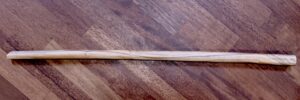These are all wonderful woods. They are just not ideal for impact weapons training, for various reasons.
Ash – Ash is flexible and reasonably strong. It is prone to horizontal splitting along the grain, particulary if felled outside the winter months. It has a striped grain – and although the texture feels a lot like oak in the hands, it’s a little lighter. It “rings” in the hands upon impact in an unpleasant way. It makes the ideal baseball bat, but it is just not strong enough for repeated hard impact. The striped grain has alternating areas of harder and softer wood – a density gradient – so it dents easily. Superior to beech, but marginal.
- Bending strength – 14,533 psi
- Maximum Crushing strength – 6763 psi
- Shearing strength – 2079 psi
- Static bending – 7501 psi
- Toughness – 250 in-lbs
- Work to Maximum Load – 21 in-lbs./in3
- Janka Hardness Scale – 1264 – 1640
Beech – The Greek Araki-ryu and Buko-ryu groups have had a number of naginata and bokken made from European beech (Fagus sylvatica). It is marginal. The wood is not strong enough to direct impact. It is as hard as many other woods, but the grain is short – little “binds” the wood together. In addition, there is just something wrong with the feel in the hands. If there is no other hardwood available, beech will do – but just barely.
- Bending strength – 15,850 psi
- Maximum Crushing strength – 7593 psi
- Shearing strength – 2090 psi
- Work to Maximum Load – 17 in-lbs./in3
- Janka Hardness Scale – 1300- 1453
Biwa (Loquat) – This wood is legendary in Japan, partly because of a myth that a bruise from a biwa weapon will fester in some way. In fact, it is a very attractive, light fruitwood, pinkish in color. It dents easily. It has qualities similar to pear wood – light, hard, attractive. I found it to be a wonderful bokken to hold – it has a particular quality of liveness.
Toda Seigen, the founder of the Toda-ryu, is said to have used a biwa kodachi in matches against two men armed with take-yari. This, in particular, makes sense, because the bamboo spears, cut on a bias, would have been light and fast, and Toda would have needed every advantage of speed he could have. Additionally, because he would be deflecting or striking down the thrusts of the hollow bamboo, he would not have had to worry about damage to his weapon. Other than harkening to tradition, I would not recommend this wood for everyday practice weapons.Biwa is tremendously rare – it is very unlikely that one would be able to secure a real biwa (hon-biwa) weapon in Japan. Almost surely, they will be camelia. Janka Hardness Scale ????
Chinese Waxwood (Glossy Privet, Chinese Privet or Broad-leaf Privet – Ligustrum lucidum) – Waxwood are used a lot in Chinese weapons – particularly staff (kun) and spear. It is a very tough wood – I am guessing that it has very long fibers. Although quite light, it takes a lot of impact, in part due to it’s incredible flexibility. Waxwood weapons are wonderful for internal training regimen (“pole shaking”), but in my experience, not suitable for Japanese long-weapon practice. It is conceivable that some ryu might find waxwood bokuto an inexpensive alternative for dual sword practice. The weapons would have to be matched together, rather than one against a heavier wood. Janka Hardness Scale ???? [Jonathan Bluestein discussed this wood at length in his discussion on wood for weapons].
Doussie (Afzelia Africana) – a golden-brown wood, similar in properties to karri and other eucalyptus. It has an interlocked grain, which makes it strong, but subject to tear-out when planing. On paper, Doussie appeared to be a really fine wood, and it is certainly attractive. It’s numbers are much like that of hickory and a naginata fabricated of this wood, in fact, feels much like that ideal wood. But doussie dents fairly easily with moderately powerful impact. So far, the dents do not feather, but it is significant how easily the fibers of the wood crush. We have not broken one yet, but it does not give the feel of strength of impact that one feels from hickory. We will attempt to soak the weapons in a mixture of 1/2 boiled linseed oil and 1/2 tung oil to see if that will keep the wood stronger. At this time, however, it is not a recommended wood if there are other alternatives.
Bending Strength (Modulus of Rupture) = 17,740 – 19,175 psi
Density = 49 Lbs/Ft3 or 785 kg/m3
Janka Hardness = 1810
Hardness = 2,103 lbs. or 953 kg
Impact Strength = 30
Maximum Crushing Strength = 10,459 psi or 735 kg/cm2
Shearing Strength = 1941 psi or 136 kg/cm2
Stiffness = 1,888,000 psi or 1,132,000 kg/cm2
Work to Maximum Load = 11 inch-lbs/in3 or 0.77 cm-kg/cm3
Olive – Olive, a beautiful, silvery-leaved twisty tree is used in much of the Mediterranean and North Africa to make walking sticks. Clive Nicol, who worked as a game-warden in Ethiopia a number of decades ago, dealt with people who considered guns a tool only to be used to slaughter animals. To fight – or kill – a man, one used a blade or one’s walking stick. He was threatened frequently and attacked with such staves. The grain is quite wild. Reportedly, stick-fighting arts from Sicily and southern Italy used olive wood staves. It is a very light wood, with a ‘dry’ feel to it – more suitable for a walking stick than a bokken, much less a long weapon. Because of its commercial uses, olive timber is quite rare. Janka hardness of East African Olivewood (Olea hochstetteri) is 2740, Olea europaea is 1540


